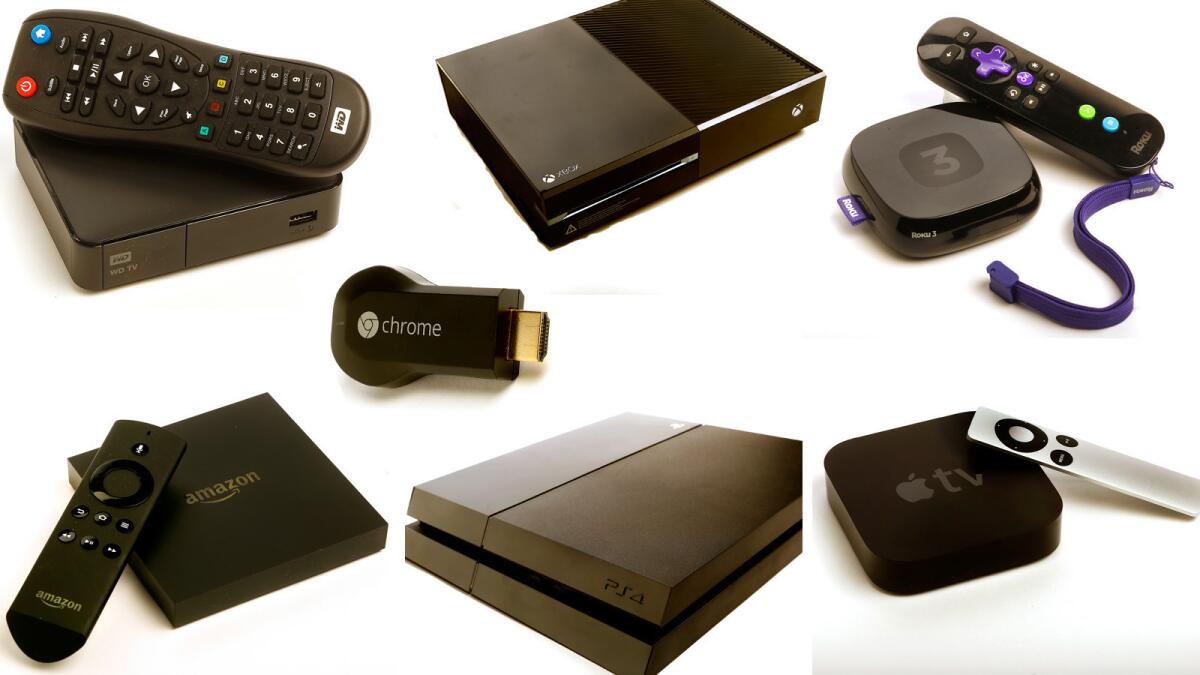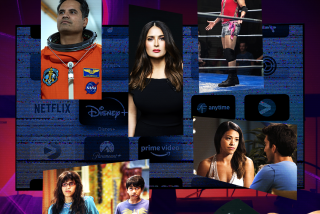Jumping into streaming TV

- Share via
More TV viewers are picking up so-called streaming media boxes in the hope of fulfilling a simple wish: Let me watch what I want when I want.
Basically, the devices, some as small as a thumb drive, link the TV to the Internet so users can watch Netflix or Hulu on the bigger screen, giving them a far wider choice of programming than cable or satellite services can.
But that’s where it can be confusing and frustrating: Every box, including Apple TV, Roku and Amazon Fire TV, has its own set of apps that feature different libraries of shows and movies. Amazon Fire TV, for example, lacks HBO Go, which allows for on-demand viewing of HBO shows.
And although streaming apps such as Netflix and Hulu have vast libraries, some TV networks and studios limit availability of their content depending on whether the user is a cable or satellite subscriber. That means streaming media boxes won’t help viewers ditch cable or satellite television subscriptions because many networks’ apps require that users also have a pay-TV account.
It can get even more confusing if you’re shopping for a device: There are now 50 streaming media boxes and 12 smaller-size sticks on the market, according to Mike Paxton, analyst at research firm SNL Kagan.
Despite the disarray and the emergence of the so-called smart TV, ownership of streaming media devices is rising and competition among manufacturers is intensifying.
When boxes including Apple TV and Roku started seeing wide adoption a couple of years ago, many analysts guessed they were merely a stopgap measure until everybody bought a TV set that could connect directly to the Internet. But adoption of smart TVs has fallen short of expectations.
Though the number of U.S. adults with high-definition TV has jumped 25 percentage points to 78% during the last four years, the tally of smart-television-owning adults has ticked up only 14 percentage points to 21%, according to media consulting firm Frank N. Magid Associates Inc. Meanwhile, the number of consumers with streaming devices is growing rapidly and is already on par with smart TVs at 21%.
One key reason: Prices for smart TVs have remained high while some streaming media devices cost $30 on sale.
“When you can just connect a media box to a dumb screen, I don’t think TV manufacturers have convinced consumers that the value proposition is there for a smart TV,” Paxton said.
Analysts attribute the popularity of streaming media boxes to one company: Netflix Inc. Two in three people buying a streaming media box just to access Netflix through a television, Paxton said. Every time the streaming service launches service in a new country, box sales pick up there.
That’s despite the growth in people watching video on their smartphones. With better cellular data plans and more Wi-Fi availability, the amount of time people spend watching full-length TV content on smartphones and tablets tripled in the last year, according to Magid data.
At home, though, many people still find that the most comfortable and enjoyable way to watch video is in front of a TV — now more than ever with a streaming media box.
At the top of the charts are Apple TV and Roku boxes. Amazon Fire TV and Google Chromecast are far behind but growing. Fewer households are using gaming consoles such as Microsoft Xbox One and Sony PlayStation 4 to connect televisions to the Web. Some DVD players and DVRs can also stream online content to televisions, but these devices typically cost more, are physically larger or have fewer apps.
By no means do streaming media boxes provide an experience that’s as frustration-free as turning on the television and flipping to a familiar channel.
Setting them up is a clunky process. Without a physical keyboard, usernames and passwords have to be entered through clicks on remote controls or gaming controllers. To activate some apps, a second Internet-connected device is required. Except for sticks such as Google’s Chromecast, streaming media devices can connect to Internet modems via Wi-Fi or Ethernet cable.
The remotes for these boxes would also add to the tabletop collection, and they lack one feature that would prove handy — volume control.
Once the boxes are set up, users download or sync apps to them. The apps serve as the access points to movies, television shows, online videos, podcasts, games and music. Some boxes even have apps to check Facebook or the weather.
If a wide variety of content is the goal, Roku and Google Chromecast do well. If buying purely based on cost, Chromecast would be best. If access to video games is critical, go with the Xbox One.
Heavy Apple iTunes buyers or iPad/iPhone users are best off with Apple TV. Amazon Prime subscribers should go with the Amazon Fire TV. People with large libraries of downloaded content from various corners of the Internet should turn to WD TV. Of course, one app they all support: Netflix.
Ultimately, buyers of a streaming media box should visit the device’s official website to make sure the two or three apps or channels that they most use are supported.
The boxes have room for improvement. Social media integration, such as sharing content to Twitter or Facebook, and personalized content recommendations are surprisingly limited across the board.
With the market expected to grow for at least for several more years, analysts said, Google, Sony, Apple and others have a significant opportunity to make the boxes more robust.
There’s a lot of work “involved right now in finding the right content,” said Magid researcher Andrew Hare. “The onus is on the industry to make it as easy as channel surfing. I don’t think we’re even tapping into how this big could change culturally how Americans view televisions.”
Twitter: @peard33
More to Read
Inside the business of entertainment
The Wide Shot brings you news, analysis and insights on everything from streaming wars to production — and what it all means for the future.
You may occasionally receive promotional content from the Los Angeles Times.











